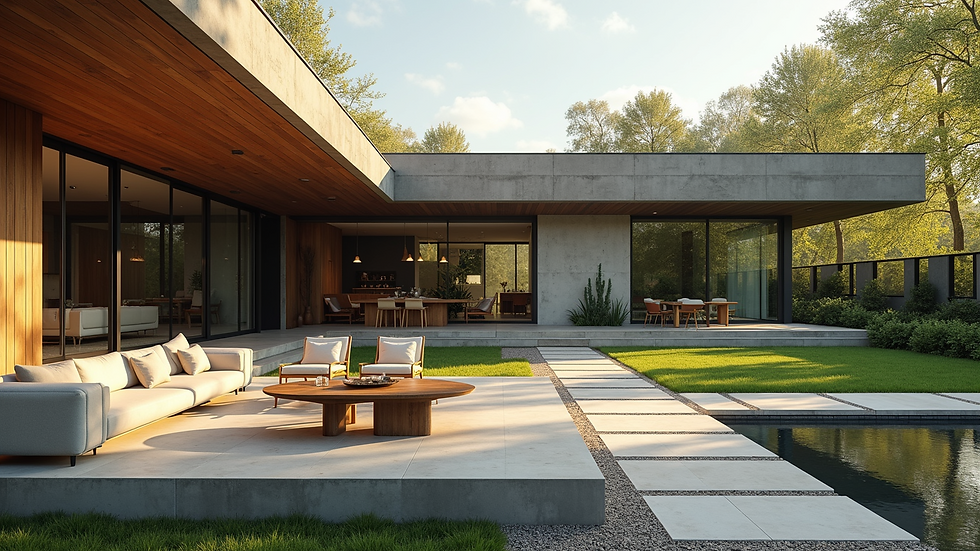Uncovering the Best Sustainable Building Materials for a Healthier Home
- nadia9613
- Mar 28
- 3 min read
As World Health Day approaches, the importance of sustainable living becomes even more evident. With climate change threatening our health and environment, adopting sustainable building materials is crucial for creating eco-friendly homes. This shift is not just about reducing carbon footprints; it’s about promoting well-being for individuals, communities, and our planet.
In this blog post, we will explore some of the best sustainable building materials that contribute to healthier homes. Let’s embark on a journey toward a greener future, one building material at a time.
The Need for Sustainable Building Materials
The construction industry significantly impacts environmental degradation. Traditional building materials often rely on manufacturing processes that release greenhouse gases and consume vast amounts of energy. For instance, concrete production alone accounts for about 8% of global CO2 emissions. Sustainable materials aim to minimize environmental impact, improve indoor air quality, and lead to healthier living spaces.
Utilizing sustainable building materials can cut energy consumption, enhance health outcomes, and strengthen community ties to nature. For example, homes built with eco-friendly materials can save homeowners 30% or more on energy costs over time.
Bamboo: A Versatile Miracle
Bamboo stands out as one of the fastest-growing plants on Earth, making it a remarkably renewable resource. This material is not only incredibly strong and flexible, but it also plays a role in absorbing carbon dioxide.
Advantages of Bamboo
Sustainability: Bamboo can grow up to 39 inches in a single day, making it an ideal rapid renewable resource for construction.
Durability: When treated properly, bamboo can match the strength of steel, offering a viable alternative to traditional timber.
Aesthetic Appeal: Its unique natural look can add an elegant touch to any home’s interior or exterior.

Hempcrete: The Eco-Friendly Insulator
Hempcrete is gaining popularity as a green alternative to traditional concrete, utilizing industrial hemp in its production. This material is lightweight, strong, and effective at regulating humidity and temperature inside homes.
Benefits of Hempcrete
Insulation Properties: Hempcrete offers outstanding insulation that can cut heating and cooling costs by up to 50%.
Bio-Friendly: It naturally resists mold and pests, creating a healthier living environment.
Carbon Negative: The production of hempcrete absorbs more carbon dioxide than is emitted during its manufacture, making it a sustainable building option.
Recycled Steel: A Stronger Future
Recycled steel is another sustainable building material that is gaining momentum. Made from scrap steel, it significantly reduces the need for mining new materials. In fact, using recycled steel can use up to 74% less energy compared to virgin steel production.
Why Choose Recycled Steel?
Strength: Steel has an impressive strength-to-weight ratio, ensuring buildings maintain durability without sacrificing structural integrity.
Repurpose and Reduce Waste: Opting for recycled steel helps conserve resources and minimizes landfill waste.
Low Maintenance: Steel is resistant to pests and does not rot, which translates to lower maintenance costs over time.
Recycled Plastic: Turning Waste into Value
Recycled plastic is an unexpected building material, but it has emerged as a significant alternative. Made from post-consumer waste, it can be used for applications like decking, fences, and structural components.
The Advantages of Recycled Plastic
Durability: This material is resistant to moisture, insects, and UV exposure, which means it requires minimal upkeep.
Lightweight: Recycled plastic components are easier to handle and transport than their wood counterparts.
Environmentally Friendly: Utilizing waste plastic helps prevent landfill overflow while protecting trees from being cut down for wood production.

Building a Greener Tomorrow
Creating an eco-friendly home is more than selecting the right building materials; it reflects a commitment to sustainability. By incorporating materials like bamboo, hempcrete, recycled steel, engineered wood, and recycled plastic, homeowners can significantly lower their ecological footprints while enhancing their quality of life.
As we observe World Health Day, let’s acknowledge how our building choices affect our well-being and that of our environment. By making informed decisions about construction, we can contribute to a healthier planet and create nurturing spaces that promote health and happiness for ourselves and future generations.
Together, let’s build a greener future!






Comments